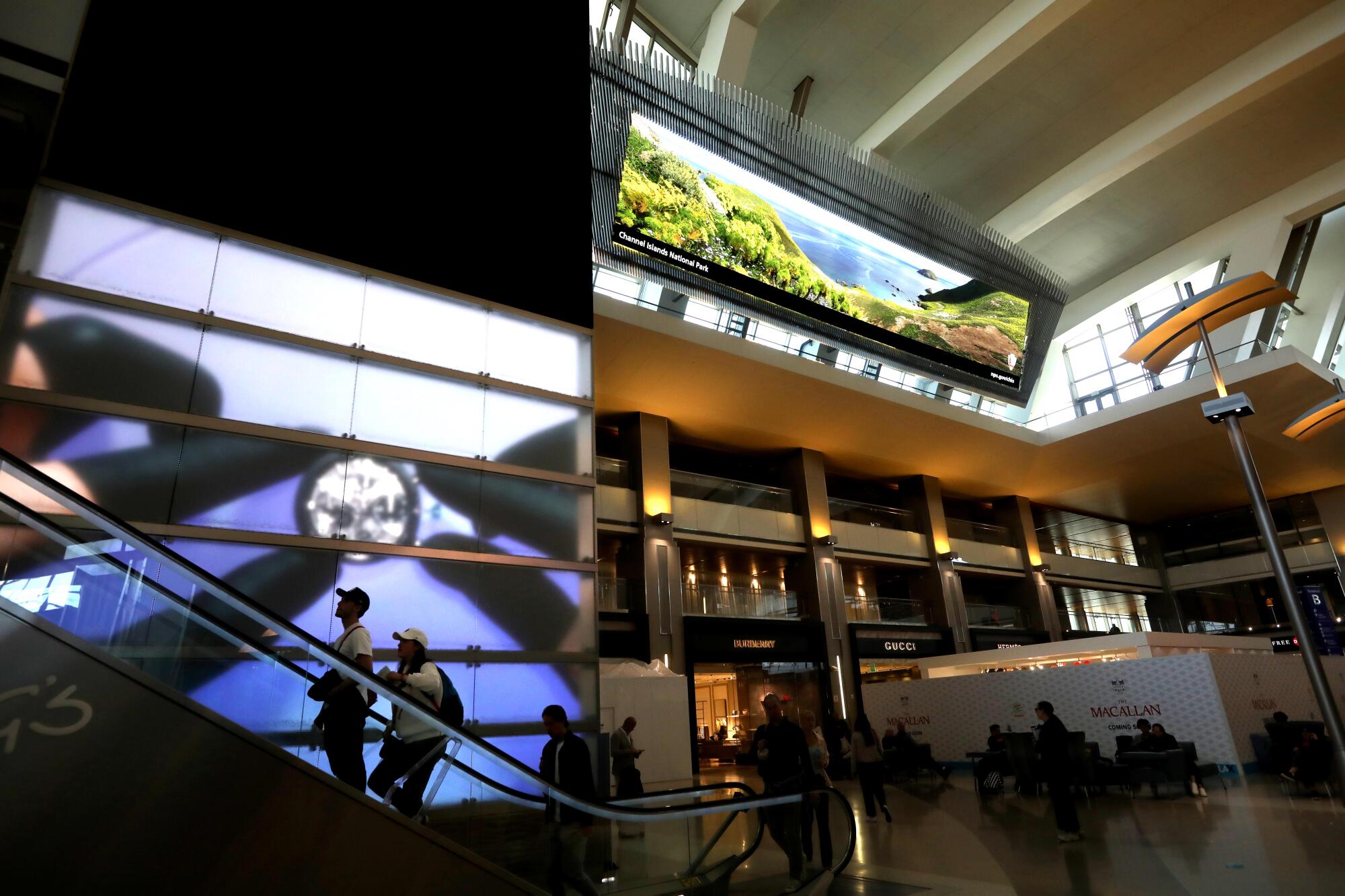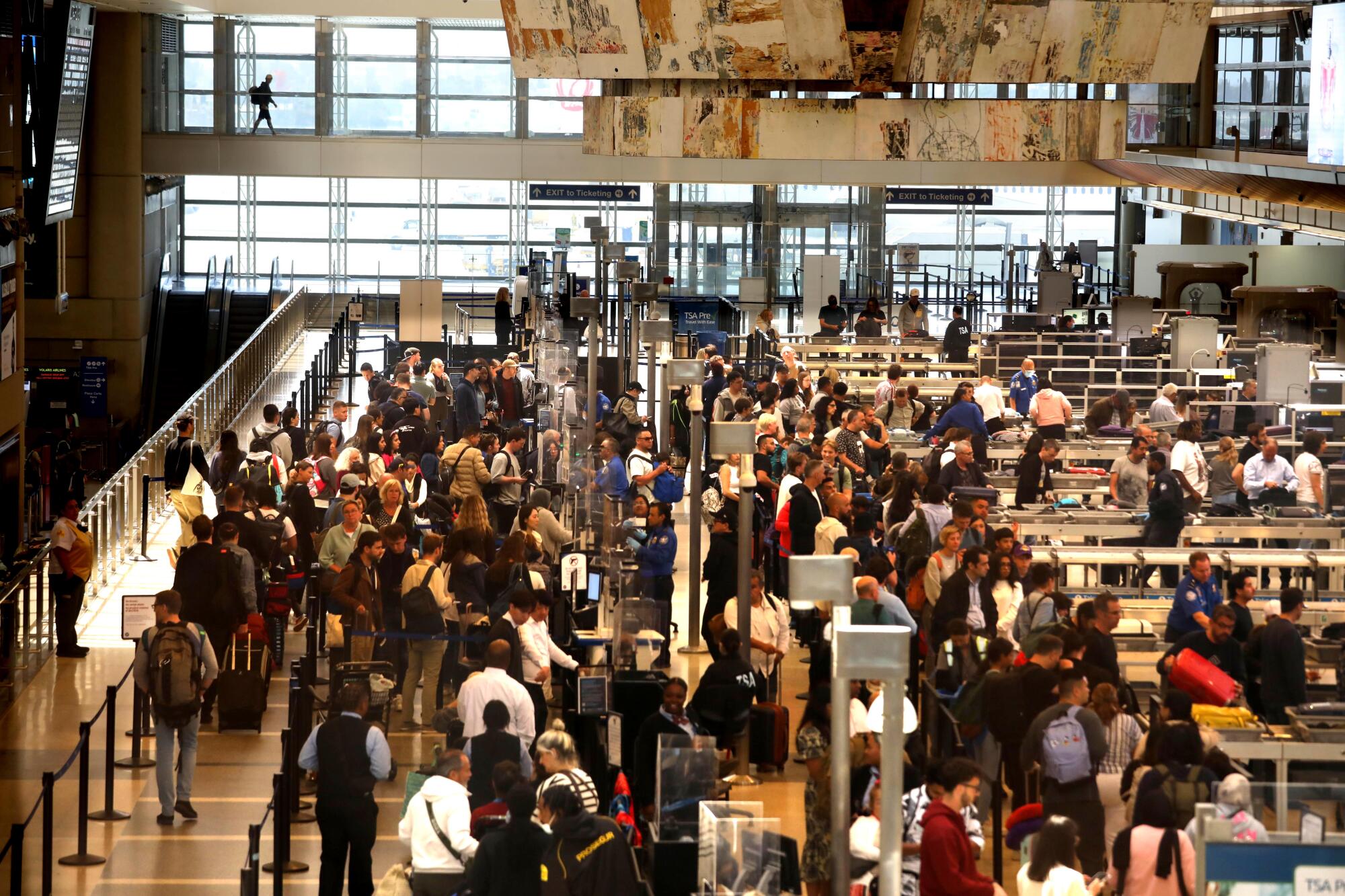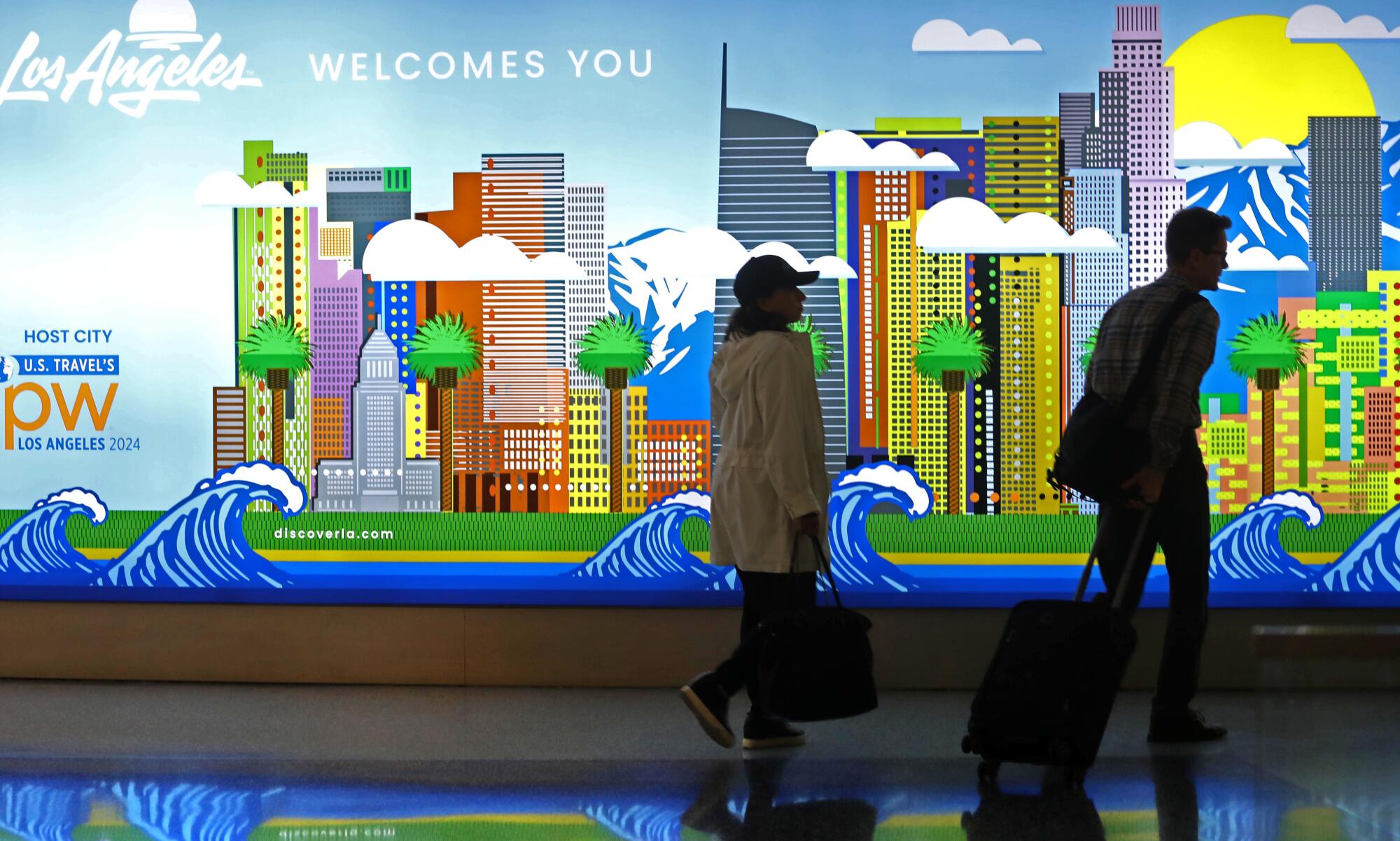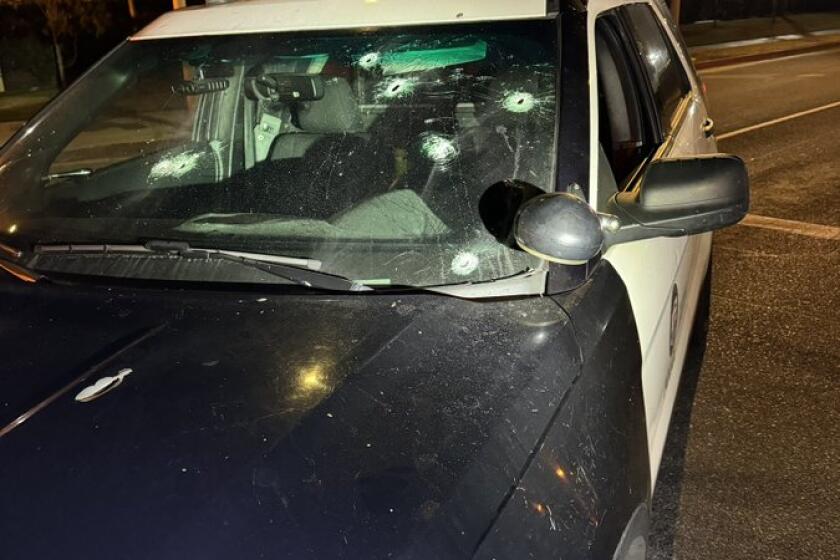
Alexa Woodward arrived in California for the first time and was immediately lost. Outside Los Angeles International Airport, she and a friend tried unsuccessfully to order an Uber. The hum of jackhammers added to the anxiety, and except for the smell of weed in the air, this wasn’t the introduction she had expected.
“It’s not super clean, there’s lots of construction, and we don’t know where to go,” the North Carolinian said, before a Times reporter led her to the shuttle for the designated taxi and ride-share lot.
For decades, the trip in and out of LAX has been one of the most challenging parts of a journey. The serenity of the Pacific Ocean is only two miles away, but that can be difficult to remember as travelers spend an hour on the nightmarish horseshoe loop known as 1 World Way.
A $30-billion overhaul promises to make the experience better before the 2028 Olympics and the airport’s centennial. A glimpse of the elevated tracks of the long-awaited Automated People Mover soaring above the airport teases at the future. But until the system is complete, the chaos that many have endured before takeoff and after landing remains all but inevitable without extensive trip planning, extra time to allow for delays or travel at non-peak hours — especially for first-timers trying to navigate the airport.

“This is the worst airport I’ve ever been to,” Jennifer Martin said. The Salt Lake City resident, her husband and two young kids gave up on finding the free shuttle that would take them to the rental car area after asking about 10 people for directions. They ultimately opted to spend on a ride-hail service in order to avoid more stress.
“It is a complete cluster,” said Martin. “We should have flown into San Diego.”
LAX sees few travelers on layover, just moving from one terminal to the next.
The money will be used to settle claims between the Automated People Mover contractor and Los Angeles International Airport.
“About 65% of people are coming from or going to the Los Angeles area,” said Megan Ryerson, the UPS chair of transportation at the University of Pennsylvania.
While other major airports, such as Hartsfield-Jackson Atlanta International, are hubs for connections, LAX is used mainly for nonstop flights. That has led to ground transportation traffic that has only increased as flight travel has expanded and L.A. County’s population has grown from 4 million in 1950 — a year after the airport became an international destination — to 10 million today.
Roughly 700 nonstop flights arrive and depart each day, and about 70 airlines fly in and out. The airport saw more that 75 million travelers last year — a number that hasn’t surpassed the pre-pandemic peak in 2019 but has increased from roughly 67 million in 2000 and 35 million in 1979.

This all means that hundreds of thousands of travelers funnel in and out each week via one road that is also utilized by many of the more than 50,000 airport employees. And that road’s main connection is to one of the nation’s most infamously clogged freeways: the 405.
“Things that were perfectly reasonable in 1966 become problematic in 2024,” said Brian Taylor, director of the Institute of Transportation Studies at UCLA.
Unlike some other airports, Joshua Schank of InfraStrategies said LAX doesn’t have a significant issue with airside capacity (the amount of air traffic and aircraft operations it can handle at a given time), largely due to four runways that take advantage of the typically good weather. Instead, most problems have centered around landside access.
“That’s why LAX is so focused on building better terminals and wider terminals that can accommodate more people,” Schank said. “If they want to grow, they have to grow on the landside and accommodate greater numbers of people getting to the airport.”
Without a direct public transit connection, such as exists at most airports throughout the country, the bottleneck will get worse with more passengers. And while the horseshoe loop design isn’t uncommon (it’s also seen at New York’s John F. Kennedy International Airport), LAX is limited to one entrance and one exit that dumps onto busy Century and Sepulveda boulevards before drivers make their way to the freeway.
The airport has tried to address capacity needs over the years with the addition of the Tom Bradley International Terminal and a second-level roadway ahead of the 1984 Olympics. But those extra lanes didn’t take long to jam up as the yearly average number of passengers over the past four decades grew.
LAX recently established two cellphone waiting lots outside the airport, where drivers can sit for up to two hours as they wait for someone to land, in an attempt to ease traffic, and the nearby LAXit lot designated for ride-hail services and taxis. Those additions don’t necessarily save passengers time and aren’t apparent for everyone. Taking the shuttle or walking to the LAXit lot might add 30 minutes or more to a trip.
“They’ve done more and more over time to move the cars onto the outer part of the roadway and be able to move the shuttle buses more quickly,” Taylor said. But “the easiest default is to drive [to a parking structure] or even get dropped off.”
On-site parking is steep, at about $60 a day, and while there is budget parking away from the airport, the price can add up.
The People Mover could eliminate some of the traffic in the horseshoe by taking passengers to and from airport terminals, the Metro C Line, long-term and short-term parking and a consolidated rental car facility. The $2.2-billion rental car project under construction will house more than 18,000 vehicles in a 6.3-million-square-foot space near the 405.
Owner Los Angeles World Airports has allocated $2.9 billion for the 2.25-mile People Mover line, which is expected to open in late 2025.

The train is expected to significantly reduce vehicular traffic — if travelers can change long-standing habits.
“There’s all sorts of reasons to believe that when this new capacity is finally up and running, it will take a lot of pressure off the airport [traffic],” Taylor said.
Los Angeles Airport’s board of commissioners has designated $43.6 million to improve the ways travelers navigate the airport.
The addition could also have a ripple effect across Los Angeles.
“A lot of the traffic in the city is attributable to people going to and from the airport,” Ryerson said. “So if we could reduce it even a little, it could have really big positive impacts throughout.”
Ryerson said that key to improving congestion outside of the airport is effectively communicating to outsiders how to utilize transit options, such as the Flyaway bus that takes travelers to and from Union Station or Van Nuys for less than $10 each way. Travelers can also take a free airport shuttle to and from Metro’s C Line stop at Aviation if they allow for the extra time.

“When we think about transportation planning, it is absolutely critical to think, ‘Who are we planning for?’” she said. “Is your transit system accessible and understandable for people who have never been here before?”
It took Toronto resident Gupreeth Sethi about 30 minutes to figure out how to get her Disneyland-bound family to baggage claim and to the ride-hail area at LAX.
“It wasted my time,” Sethi said.
Her partner, Lucky Singh, said no employee was readily available to help them, and for anyone but frequent fliers, the system is complicated to navigate.
“It was a lot of struggle to get here,” Singh said. “It should be done better.”
LAX recently designated $43 million to update its signage and terminal and gate numbering system to improve the way travelers navigate the airport.
Ticketed travelers suddenly have the freedom to roam all nine terminals. So, what should you do, see and eat?
For example, it’s not obvious that all terminals at LAX connect. That means that once past security, fliers can make their way from any terminal to shiny Tom Bradley International for sushi or wine and to shop for luxury brands like Tumi and Hermes. They can catch a live music show while plane-spotting at West Gates, take advantage of one of the freestanding pianos at Terminals 4 and 7 or explore art installations at Terminals 1 and 2.
In this transition state, the mix of old and new, airy and cramped, can be disorienting. Parts of the 2.2.-mile interior horseshoe go from gleaming glass walkways with colorful murals and paintings to narrow, dimly lit corridors filled with exposed wires and blowing fans. The goal is for a more seamless travel experience by 2028.
Getting to and from LAX isn’t a struggle for everyone, especially those who know their way around and travel at non-peak hours.
For some visitors, the experience is better than what they’re used to at their home airports. A newly engaged couple from Atlanta said the construction felt minimal compared to what they routinely encounter at Hartsfield-Jackson, the busiest airport in the U.S.
“The grass isn’t always greener,” Julian Thomas said.

Billions of dollars have gone into updating terminals, including a nearly $980-million update and extension of Terminal 1; $1.7 billion to modernize Tom Bradley’s West Gates; $1.6 billion to update Terminals 4 and 5 and centralize the ticketing, screening and baggage claim areas; and $230 million to improve Terminal 6. An additional concourse is being built off-site and will be transferred to LAX upon completion.
The airport has gradually expanded for decades with limitations, Taylor said. And while offloading some airline traffic to another regional airport could help ease capacity, an airport can’t easily force an airline to move out.
Ryerson said it’s a “delicate dance” between how airports update infrastructure and how airlines plan their networks as both independently try to anticipate travel and passenger needs.
“Airport planners are making decisions with the information they have now, and then thinking toward the future as best that they can,” she said, pointing out that many airports were first built near water, when seaplane travel was expected to dominate.
“You can’t build half a runway; you can’t build half an airport. You have to go all in with these big infrastructure decisions,” she said about what is in part guesswork. “We’re stuck with the results for decades.”
More to Read
Subscriber Exclusive Alert
If you're an L.A. Times subscriber, you can sign up to get alerts about early or entirely exclusive content.
You may occasionally receive promotional content from the Los Angeles Times.









